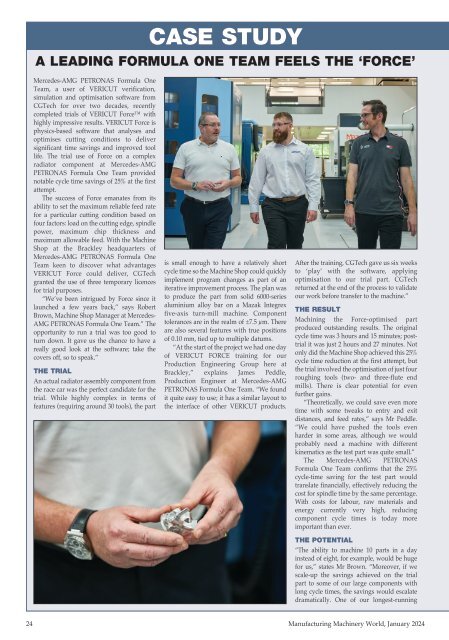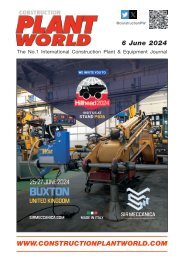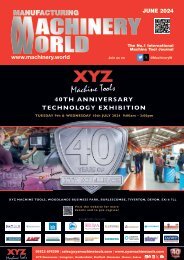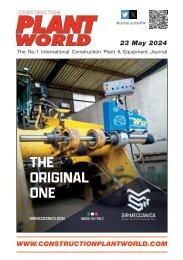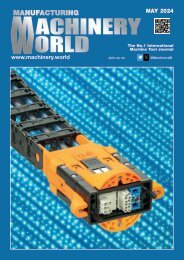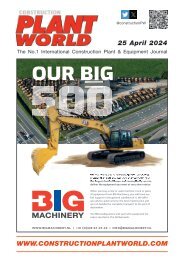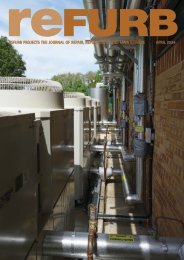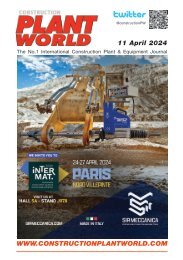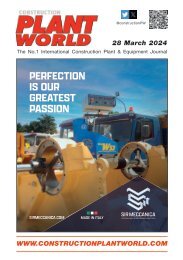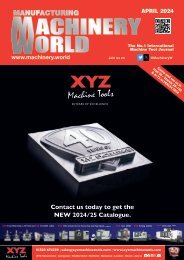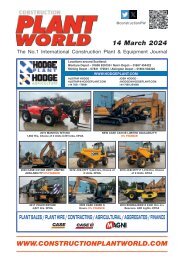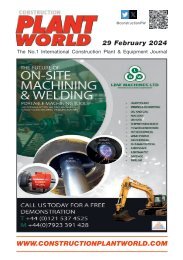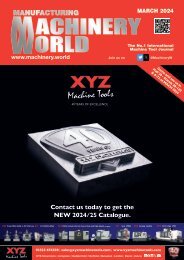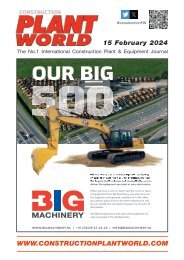Manufacturing Machinery World January 2024
Machinery World was launched in 1982 to serve the machinery & production engineering market. Editorially Machinery World is a news and information source that gives direct contact with the provider of innovative services and equipment. Editorial is available both online and as hard copy.
Machinery World was launched in 1982 to serve the machinery & production engineering market.
Editorially Machinery World is a news and information source that gives direct contact with the provider of innovative services and equipment. Editorial is available both online and as hard copy.
Create successful ePaper yourself
Turn your PDF publications into a flip-book with our unique Google optimized e-Paper software.
CASE STUDY<br />
A LEADING FORMULA ONE TEAM FEELS THE ‘FORCE’<br />
Mercedes-AMG PETRONAS Formula One<br />
Team, a user of VERICUT verification,<br />
simulation and optimisation software from<br />
CGTech for over two decades, recently<br />
completed trials of VERICUT Force with<br />
highly impressive results. VERICUT Force is<br />
physics-based software that analyses and<br />
optimises cutting conditions to deliver<br />
significant time savings and improved tool<br />
life. The trial use of Force on a complex<br />
radiator component at Mercedes-AMG<br />
PETRONAS Formula One Team provided<br />
notable cycle time savings of 25% at the first<br />
attempt.<br />
The success of Force emanates from its<br />
ability to set the maximum reliable feed rate<br />
for a particular cutting condition based on<br />
four factors: load on the cutting edge, spindle<br />
power, maximum chip thickness and<br />
maximum allowable feed. With the Machine<br />
Shop at the Brackley headquarters of<br />
Mercedes-AMG PETRONAS Formula One<br />
Team keen to discover what advantages<br />
VERICUT Force could deliver, CGTech<br />
granted the use of three temporary licences<br />
for trial purposes.<br />
“We’ve been intrigued by Force since it<br />
launched a few years back,” says Robert<br />
Brown, Machine Shop Manager at Mercedes-<br />
AMG PETRONAS Formula One Team.” The<br />
opportunity to run a trial was too good to<br />
turn down. It gave us the chance to have a<br />
really good look at the software; take the<br />
covers off, so to speak.”<br />
THE TRIAL<br />
An actual radiator assembly component from<br />
the race car was the perfect candidate for the<br />
trial. While highly complex in terms of<br />
features (requiring around 30 tools), the part<br />
is small enough to have a relatively short<br />
cycle time so the Machine Shop could quickly<br />
implement program changes as part of an<br />
iterative improvement process. The plan was<br />
to produce the part from solid 6000-series<br />
aluminium alloy bar on a Mazak Integrex<br />
five-axis turn-mill machine. Component<br />
tolerances are in the realm of ±7.5 µm. There<br />
are also several features with true positions<br />
of 0.10 mm, tied up to multiple datums.<br />
“At the start of the project we had one day<br />
of VERICUT FORCE training for our<br />
Production Engineering Group here at<br />
Brackley,” explains James Peddle,<br />
Production Engineer at Mercedes-AMG<br />
PETRONAS Formula One Team. “We found<br />
it quite easy to use; it has a similar layout to<br />
the interface of other VERICUT products.<br />
After the training, CGTech gave us six weeks<br />
to ‘play’ with the software, applying<br />
optimisation to our trial part. CGTech<br />
returned at the end of the process to validate<br />
our work before transfer to the machine.”<br />
THE RESULT<br />
Machining the Force-optimised part<br />
produced outstanding results. The original<br />
cycle time was 3 hours and 15 minutes; posttrial<br />
it was just 2 hours and 27 minutes. Not<br />
only did the Machine Shop achieved this 25%<br />
cycle time reduction at the first attempt, but<br />
the trial involved the optimisation of just four<br />
roughing tools (two- and three-flute end<br />
mills). There is clear potential for even<br />
further gains.<br />
“Theoretically, we could save even more<br />
time with some tweaks to entry and exit<br />
distances, and feed rates,” says Mr Peddle.<br />
“We could have pushed the tools even<br />
harder in some areas, although we would<br />
probably need a machine with different<br />
kinematics as the test part was quite small.”<br />
The Mercedes-AMG PETRONAS<br />
Formula One Team confirms that the 25%<br />
cycle-time saving for the test part would<br />
translate financially, effectively reducing the<br />
cost for spindle time by the same percentage.<br />
With costs for labour, raw materials and<br />
energy currently very high, reducing<br />
component cycle times is today more<br />
important than ever.<br />
THE POTENTIAL<br />
“The ability to machine 10 parts in a day<br />
instead of eight, for example, would be huge<br />
for us,” states Mr Brown. “Moreover, if we<br />
scale-up the savings achieved on the trial<br />
part to some of our large components with<br />
long cycle times, the savings would escalate<br />
dramatically. One of our longest-running<br />
24 <strong>Manufacturing</strong> <strong>Machinery</strong> <strong>World</strong>, <strong>January</strong> <strong>2024</strong>


